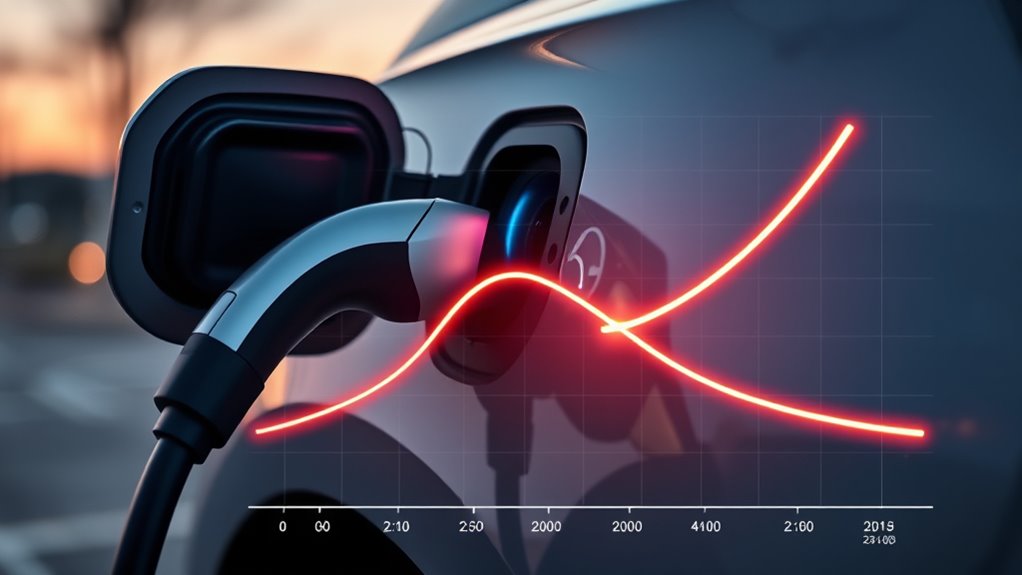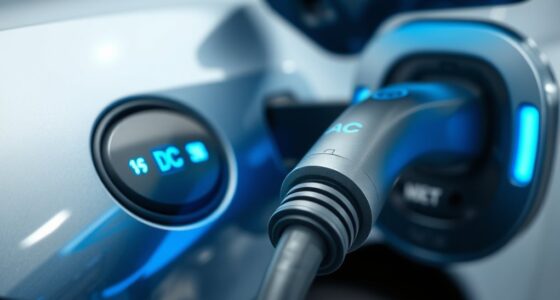Charging curves show how your battery’s voltage and current change as it charges, explaining why the process isn’t always steady. Initially, you get a fast charge, but as the battery fills, the charger reduces current to protect it. This slowing down, called tapering, happens because internal resistance increases and prevents overheating, ensuring safety. If you keep exploring, you’ll discover the detailed reasons behind this managed process and its importance for battery health.
Key Takeaways
- Charging curves show voltage and current changes as a battery fills, illustrating why charging isn’t always uniform.
- During initial charging, high current speeds up the process until about 80% capacity.
- Near full charge, current reduces to prevent damage, causing the tapering effect in the curve.
- Increased internal resistance as the battery nears full capacity slows charging and prevents overheating.
- Tapering ensures safe, controlled completion of charging by protecting battery health.

Have you ever wondered how a battery charges over time? When you connect your device to a power source, the charging process isn’t just a simple, straight line. Instead, it follows a specific pattern known as a charging curve, which reveals how the battery’s voltage and current change as it fills.
Understanding this curve can help you grasp why charging isn’t always uniform and why it tapers off toward the end.
Knowing the charging curve explains why batteries charge faster initially and slow down near full capacity.
Initially, when you plug in your device, the charger delivers a high current to the battery. This phase is called the constant current stage. During this period, the battery voltage gradually rises as it quickly absorbs energy. You might notice that charging feels faster at this stage, and the battery charges from empty to about 80% quite rapidly.
This rapid or bulk charging phase is efficient because the battery can safely accept a high current without risking damage.
But as the battery approaches full capacity, the charging process begins to change. The charger reduces the current to prevent overcharging and damage, entering what’s called the tapering phase.
During this stage, the voltage continues to increase, but the current tapers off, slowing the overall charging rate. This is the tapering part of the curve, and it’s vital for preserving the battery’s health. The taper ensures the battery isn’t subjected to excessive heat or stress as it reaches its maximum capacity.
You might notice that the last 20% of charging takes longer than the first 80%, and that’s entirely normal.
This tapering effect is driven by the chemistry inside the battery. As the battery fills, it becomes more difficult for additional ions to move freely, creating internal resistance. internal resistance plays a key role in limiting the flow of current as the battery nears full charge.
The charger responds by lowering the current to prevent overvoltage and overheating. Think of it like filling a glass of water: pouring quickly fills the glass fast at first, but as it nears the rim, you slow down to avoid spilling.
The battery’s internal resistance acts like that slowdown, ensuring a safe, controlled finish to the charging process.
Frequently Asked Questions
How Do Temperature Changes Affect Charging Curves?
Temperature changes directly impact your charging curve. When it’s cold, your battery’s internal resistance increases, slowing down the charging process and causing the curve to taper sooner.
Conversely, in warmer conditions, your battery charges more efficiently, allowing for a steadier, faster charge.
Extreme heat can also damage your battery over time.
To optimize charging, try to keep your battery within the recommended temperature range during charging sessions.
Can Fast Charging Damage Battery Longevity?
Fast charging can indeed impact your battery’s longevity if you’re not careful. It speeds up the charging process, but it also generates more heat, which can accelerate battery wear over time.
To protect your battery, avoid frequent rapid charges, use manufacturer-recommended chargers, and keep your device cool during charging sessions.
Why Do Different Batteries Have Varying Charging Curves?
Different batteries have varying charging curves because of their unique chemistries, designs, and capacities.
You’ll find that lithium-ion, nickel-metal hydride, and other battery types respond differently to charging processes. These differences influence how quickly they can be charged and how their voltage and current change over time.
How Does Battery Age Influence Charging Taper?
As your battery ages, you’ll notice the charging taper becomes more pronounced. This happens because the battery’s capacity diminishes over time, causing it to reach its maximum charge more quickly and slow down sooner.
The internal chemistry also degrades, making it harder for the battery to accept and store energy efficiently. So, with age, expect longer charging times and a quicker taper, indicating reduced overall battery health.
Are There Ways to Optimize Charging for Faster Full Capacity?
Did you know that optimizing your charging habits can cut charging time by up to 20%? To charge faster and reach full capacity quicker, avoid frequent full charges and use rapid chargers when available.
Keep your battery cool during charging and don’t let it drain completely before recharging. These simple steps help maintain your battery’s health and speed up the charging process, ensuring you get back on the road sooner.
Conclusion
Think of charging your device like filling a pool—you start fast, pouring in water quickly, then slow down as it nears the top. That tapering curve isn’t a flaw; it’s the pool’s way of preventing overflow. Just like a careful swimmer, your battery slows to protect itself, ensuring longevity. So next time you see the charging slow down, remember, it’s a smart dance of science and safety—your battery’s way of staying healthy for the long run.









